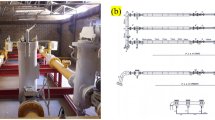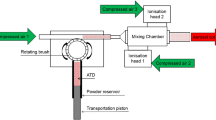Abstract
The U.S. EPA has conducted an evaluation of a commercially available lightweight fine particle personal sampler for use in human exposure and biomarker studies involving 24-h collections of particulate matter, particle-bound organics such as polycyclic aromatic hydrocarbons (PAHs), and semivolatile organics (PAHs). Independent laboratory evaluation of the prototype design, intended to produce a 2.5-μm aerodynamic diameter cut-point at a flow between 1.5 and 1.7 lpm (liters per minute), indicated that at a challenge flow rate of 1.5 lpm, the sampler provided an aerodynamic cut-point (dp50) of only 1.7 μm. The variance between expected size selection resulted from the prototype's jet diameter dimension being inadvertently based upon a flow rate of 2.0 lpm rather than an intended 1.5–1.7 lpm. Other aerodynamic factors not presently accounted for may also have played an influence. Extrapolated cut-points for flow rates at 1 and 3 lpm for the prototype were determined to be 2.1 and 1.2 μm, respectively. Total losses attributed to unwanted particle retention within the sampler ranged from 10% for 0.91 μm size particles to essentially zero approaching diameters greater than 2.0 μm. The ambient concentration of particles (<1.7 μm) needed for acceptable gravimetric filter measurements involving 24-h sample collection was determined to be 10 μg/m3. Investigation of the sampler to retain and recover PAHs using XAD-2 resin, often of importance in human exposure biomarker studies, indicated that corrected recoveries between 94% and 108% could be obtained for 16 priority pollutant PAH species. Overall evaluation of the personal monitor indicates that it has research utility due to its modular features and size but reconfiguration should be performed that would permit true PM2.5 size selection. The current configuration collects particles less than 2.5 μm at approximately 95% collection efficiency.
This is a preview of subscription content, access via your institution
Access options
Subscribe to this journal
Receive 6 print issues and online access
$259.00 per year
only $43.17 per issue
Buy this article
- Purchase on Springer Link
- Instant access to full article PDF
Prices may be subject to local taxes which are calculated during checkout
Similar content being viewed by others
Author information
Authors and Affiliations
Corresponding author
Additional information
The research described here has been reviewed in accordance with U.S. Environmental Protection Agency policy and approved for publication. Mention of trade names or commercial products does not constitute endorsement or recommendation for use.
Rights and permissions
About this article
Cite this article
WILLIAMS, R., WATTS, R., STEVENS, R. et al. Evaluation of a personal air sampler for twenty-four hour collection of fine particles and semivolatile organics1. J Expo Sci Environ Epidemiol 9, 158–166 (1999). https://doi.org/10.1038/sj.jea.7500028
Received:
Accepted:
Published:
Issue Date:
DOI: https://doi.org/10.1038/sj.jea.7500028
Keywords
This article is cited by
-
Personal exposure to carcinogenic polycyclic aromatic hydrocarbons in the Czech Republic
Journal of Exposure Science & Environmental Epidemiology (2013)
-
Human exposures to PAHs: an eastern United States pilot study
Environmental Monitoring and Assessment (2013)
-
The design and field implementation of the Detroit Exposure and Aerosol Research Study
Journal of Exposure Science & Environmental Epidemiology (2009)
-
Monitoring of PAHs in air by collection on XAD-2 adsorbent then microwave-assisted thermal desorption coupled with headspace solid-phase microextraction and gas chromatography with mass spectrometric detection
Analytical and Bioanalytical Chemistry (2007)



